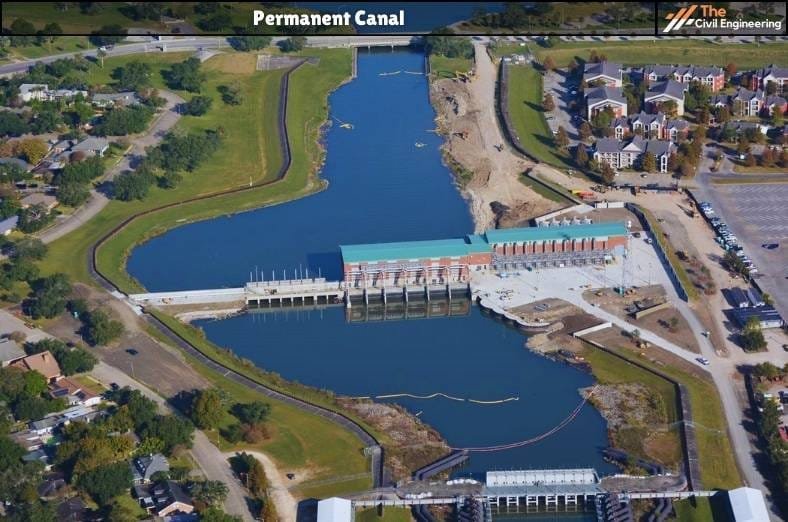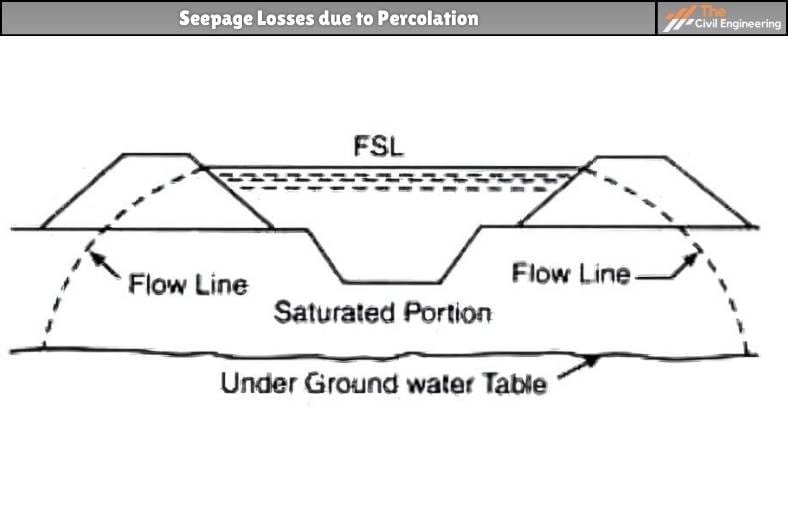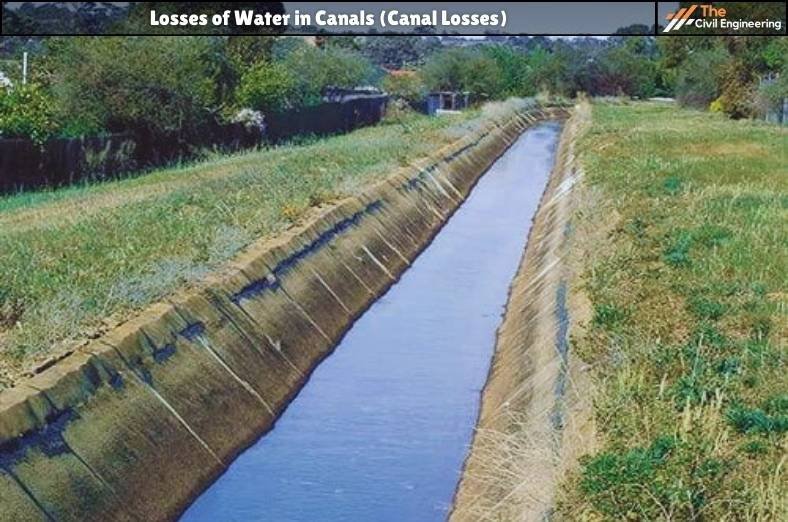Canals can be understood as the water channels that are constructed to allow the water to flow through them. They are also commonly referred to as artificial waterways. They are essential in various areas such as irrigation, navigation, etc.
During the flow or passage of water through canals, some amount of water is lost due to processes such as evaporation, seepage, etc. Such a phenomenon leads to the losses of water in canals.
1. Introduction
Losses of water in canals may be defined as the process in which a considerable amount of water is lost as it passes through the canal from the starting of the headwork to the final point where it is supplied to the agricultural field or elsewhere.
The loss of water in canals is also commonly referred to as transit loss or transmission loss.

Fig: Canal
The major losses in the canals result from evaporation, seepage, and transpiration.
According to the statistical data, the losses of water in canals can be as high as 20-25%. Such losses of water constitute a major part of the useable water. Hence, the losses of water in canals must be thoroughly studied and analyzed and must be considered during the design of the canal capacity.
2. Types of Losses of Water in Canals
The major types of canal losses are listed as follows:
1. Evaporation Losses in Canal
2. Seepage Losses in Canal
3. Transpiration Losses in Canal
a. Evaporation Losses in Canal
Evaporation loss in the canal is inevitable as the water flowing through any canal is exposed to the atmosphere.
According to the statistical records, evaporation losses constitute 0.25% to 1% of the total canal discharge and constitute 2 to 3% of the total water losses in the water canal.
Evaporation losses are less than the seepage losses in the canals.
The evaporation losses depend upon several factors such as temperature, humidity, wind, etc. But, the most dominant factor is temperature. On account of this, the evaporation losses are higher in summer than in winter.
However, the velocity of the wind also equally affects the rate of evaporation. Such losses are significant in the shallow depths of water.
Hence, this indicates that the evaporation losses in canals depend mostly upon the climatic conditions of the area. Such losses depend directly on the area of exposure of the surface of the water and inversely on the depth of water in the canal.
Thus, the major factors that affect the rate of losses due to evaporation in the canals can be listed as follows:
1. Temperature
2. Wind Velocity
3. Humidity
4. Area of water that is exposed to the atmosphere
b. Seepage Losses in Canal
The seepage loss in the canal is the most significant loss of water in the canals.
Such loss mainly depends upon the following factors:
1. The porosity of the soil.
2. Existing underground water table conditions.
3. The existing condition of the canal system.
4. Physical properties of the water canal such as turbidity of water.
5. Amount of silt carried by the water.
Types of seepage losses are:
a. Seepage Losses due to Percolation
It is the seepage loss in a canal in which the water is lost through a continuous zone that is formed between the canal and the water table. Such a zone that is formed consists of fully saturated soil that is capable of establishing continuity in the flow of water from the canal to the underground reservoir.
The loss of water due to percolation is depicted in the figure below.
The loss of water through percolation is greatly affected by the difference in level between the topwater surface level of the channel to the water table level.

b. Seepage Loss due to Absorption
In the canals, usually, a zone of saturation is present below the canal that is accompanied by a zone of soil with decreasing saturation which is further bounded by a zone that is saturated by the capillary action of water rising from the adjacent water table level.
As shown in the figure, two zones of saturated soil bind the unsaturated zone of the soil.

Let H be the seepage head, h be the distance between the water surface level of the canal and the bottom of the saturated zone, hc be the capillary head, then the rate of loss of water due to absorption depends upon (h + hc).
Methods Of Determining The Losses Due To Seepage
1. By the use of seepage meters.
2. By ponding method.
3. By inflow and outflow method.
3. Transpiration Losses in Canal
Some amount of water flowing through the canals is lost by the process of transpiration.
The plants, grasses, weeds, or other vegetation that grow on the banks of the canal undergo transpiration thereby resulting in loss of water from the canal.
Transpiration losses are very less in comparison to the other two losses in the canal.
3. Preventive Measures to Reduce Canal Losses
Some of the preventive measures to reduce canal losses are:
a. Canal Lining
Canal lining is the process of making the bed and sides of the canal impervious to reduce canal losses.
b. Increasing the height of the canal despite width. This reduces evaporation and percolation losses.
c. Provision of proper slope gradient to the canal to increase the velocity of the water.
d. Removal of vegetation from the canal and its sides.
| Read More: Prismatic Compass |
| Read More: Pile Foundation |

